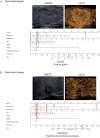Dual-modal radiomics nomogram based on contrast-enhanced ultrasound to improve differential diagnostic accuracy and reduce unnecessary biopsy rate in ACR TI-RADS 4-5 thyroid nodules
- PMID: 38263209
- PMCID: PMC10807093
- DOI: 10.1186/s40644-024-00661-3
Dual-modal radiomics nomogram based on contrast-enhanced ultrasound to improve differential diagnostic accuracy and reduce unnecessary biopsy rate in ACR TI-RADS 4-5 thyroid nodules
Abstract
Background: American College of Radiology (ACR) Thyroid Imaging Reporting and Data System (TI-RADS, TR) 4 and 5 thyroid nodules (TNs) demonstrate much more complicated and overlapping risk characteristics than TR1-3 and have a rather wide range of malignancy possibilities (> 5%), which may cause overdiagnosis or misdiagnosis. This study was designed to establish and validate a dual-modal ultrasound (US) radiomics nomogram integrating B-mode ultrasound (BMUS) and contrast-enhanced ultrasound (CEUS) imaging to improve differential diagnostic accuracy and reduce unnecessary fine needle aspiration biopsy (FNAB) rates in TR 4-5 TNs.
Methods: A retrospective dataset of 312 pathologically confirmed TR4-5 TNs from 269 patients was collected for our study. Data were randomly divided into a training dataset of 219 TNs and a validation dataset of 93 TNs. Radiomics characteristics were derived from the BMUS and CEUS images. After feature reduction, the BMUS and CEUS radiomics scores (Rad-score) were built. A multivariate logistic regression analysis was conducted incorporating both Rad-scores and clinical/US data, and a radiomics nomogram was subsequently developed. The performance of the radiomics nomogram was evaluated using calibration, discrimination, and clinical usefulness, and the unnecessary FNAB rate was also calculated.
Results: BMUS Rad-score, CEUS Rad-score, age, shape, margin, and enhancement direction were significant independent predictors associated with malignant TR4-5 TNs. The radiomics nomogram involving the six variables exhibited excellent calibration and discrimination in the training and validation cohorts, with an AUC of 0.873 (95% CI, 0.821-0.925) and 0.851 (95% CI, 0.764-0.938), respectively. The marked improvements in the net reclassification index and integrated discriminatory improvement suggested that the BMUS and CEUS Rad-scores could be valuable indicators for distinguishing benign from malignant TR4-5 TNs. Decision curve analysis demonstrated that our developed radiomics nomogram was an instrumental tool for clinical decision-making. Using the radiomics nomogram, the unnecessary FNAB rate decreased from 35.3 to 14.5% in the training cohort and from 41.5 to 17.7% in the validation cohorts compared with ACR TI-RADS.
Conclusion: The dual-modal US radiomics nomogram revealed superior discrimination accuracy and considerably decreased unnecessary FNAB rates in benign and malignant TR4-5 TNs. It could guide further examination or treatment options.
Keywords: ACR TI-RADS 4–5; Contrast-enhanced ultrasound; Nomogram; Radiomics; Thyroid nodules.
© 2024. The Author(s).
Conflict of interest statement
The authors declare that they have no competing interests.
Figures





Similar articles
-
Building radiomics models based on ACR TI-RADS combining clinical features for discriminating benign and malignant thyroid nodules.Front Endocrinol (Lausanne). 2025 Jul 21;16:1486920. doi: 10.3389/fendo.2025.1486920. eCollection 2025. Front Endocrinol (Lausanne). 2025. PMID: 40761820 Free PMC article.
-
A Comparative Study of Two Radiomics-Based Blood Flow Modes with Thyroid Imaging Reporting and Data System in Predicting Malignancy of Thyroid Nodules and Reducing Unnecessary Fine-Needle Aspiration Rate.Acad Radiol. 2024 Jul;31(7):2739-2752. doi: 10.1016/j.acra.2024.02.007. Epub 2024 Mar 7. Acad Radiol. 2024. PMID: 38453602
-
Radiomics Combined with ACR TI-RADS for Thyroid Nodules: Diagnostic Performance, Unnecessary Biopsy Rate, and Nomogram Construction.Acad Radiol. 2024 Dec;31(12):4856-4865. doi: 10.1016/j.acra.2024.07.053. Epub 2024 Oct 4. Acad Radiol. 2024. PMID: 39366806
-
Diagnostic Performance of American College of Radiology TI-RADS: A Systematic Review and Meta-Analysis.AJR Am J Roentgenol. 2021 Jan;216(1):38-47. doi: 10.2214/AJR.19.22691. Epub 2020 Nov 19. AJR Am J Roentgenol. 2021. PMID: 32603229
-
COMPARISON OF DIAGNOSTIC PERFORMANCE BETWEEN THE AMERICAN COLLEGE OF RADIOLOGY THYROID IMAGING REPORTING AND DATA SYSTEM AND AMERICAN THYROID ASSOCIATION GUIDELINES: A SYSTEMATIC REVIEW.Endocr Pract. 2020 May;26(5):552-563. doi: 10.4158/EP-2019-0237. Endocr Pract. 2020. PMID: 32396776
Cited by
-
Development and validation of a nomogram based on conventional and contrast-enhanced ultrasound for differentiating malignant from benign thyroid nodules.Quant Imaging Med Surg. 2025 May 1;15(5):4641-4654. doi: 10.21037/qims-24-1796. Epub 2025 Apr 28. Quant Imaging Med Surg. 2025. PMID: 40384666 Free PMC article.
-
Multimodal ultrasound radiomics model combined with clinical model for differentiating follicular thyroid adenoma from carcinoma.BMC Med Imaging. 2025 May 5;25(1):152. doi: 10.1186/s12880-025-01685-2. BMC Med Imaging. 2025. PMID: 40325381 Free PMC article.
-
Ultrasound radiomics and genomics improve the diagnosis of cytologically indeterminate thyroid nodules.Front Endocrinol (Lausanne). 2025 Feb 28;16:1529948. doi: 10.3389/fendo.2025.1529948. eCollection 2025. Front Endocrinol (Lausanne). 2025. PMID: 40093750 Free PMC article. Review.
-
Ultrasound radiomics models improve preoperative diagnosis and reduce unnecessary biopsies in indeterminate thyroid nodules.Front Endocrinol (Lausanne). 2025 Jul 10;16:1615304. doi: 10.3389/fendo.2025.1615304. eCollection 2025. Front Endocrinol (Lausanne). 2025. PMID: 40708722 Free PMC article.
-
Building radiomics models based on ACR TI-RADS combining clinical features for discriminating benign and malignant thyroid nodules.Front Endocrinol (Lausanne). 2025 Jul 21;16:1486920. doi: 10.3389/fendo.2025.1486920. eCollection 2025. Front Endocrinol (Lausanne). 2025. PMID: 40761820 Free PMC article.
References
-
- Haugen BR, Alexander EK, Bible KC, Doherty GM, Mandel SJ, Nikiforov YE, et al. 2015 American Thyroid Association Management Guidelines for adult patients with thyroid nodules and differentiated thyroid Cancer: the American Thyroid Association Guidelines Task Force on thyroid nodules and differentiated thyroid Cancer. Thyroid. 2016;26:1–133. doi: 10.1089/thy.2015.0020. - DOI - PMC - PubMed
MeSH terms
Grants and funding
LinkOut - more resources
Full Text Sources

